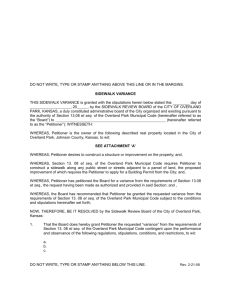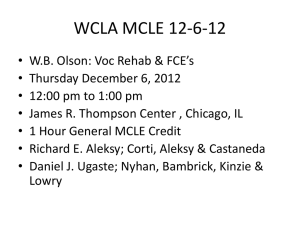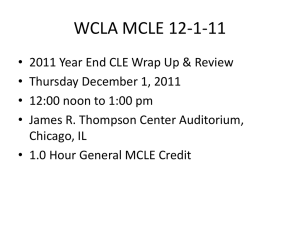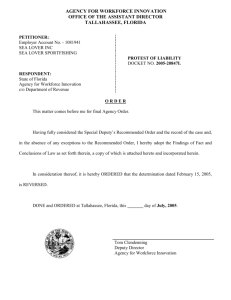Published - Office of Administrative Hearings
advertisement
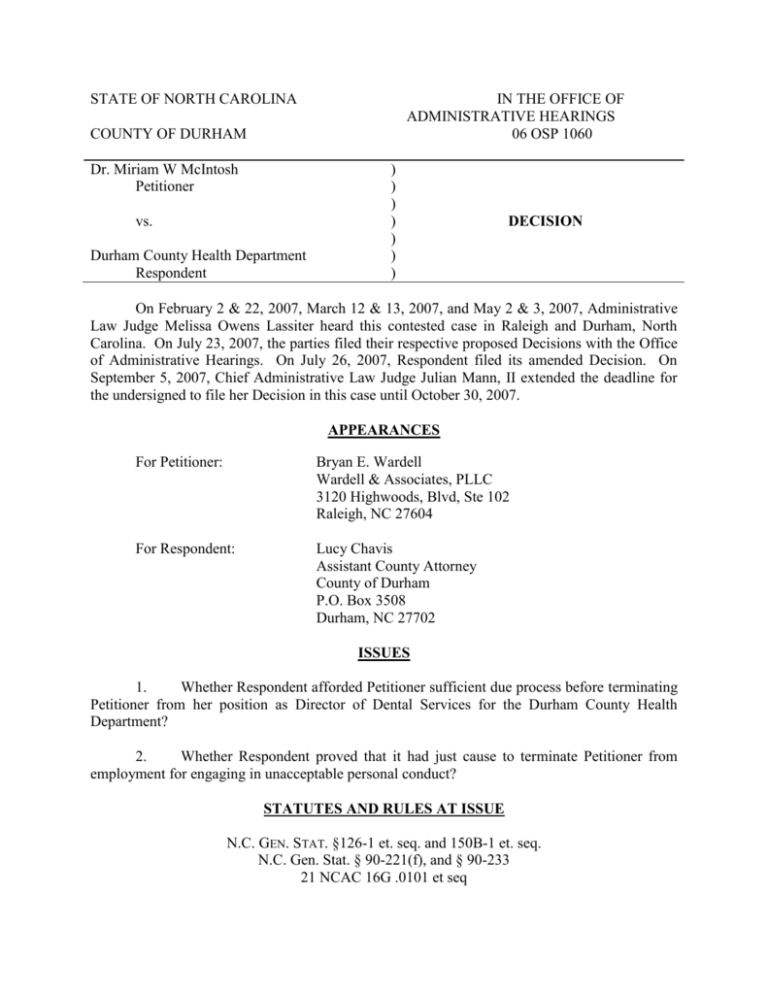
STATE OF NORTH CAROLINA IN THE OFFICE OF ADMINISTRATIVE HEARINGS 06 OSP 1060 COUNTY OF DURHAM Dr. Miriam W McIntosh Petitioner vs. Durham County Health Department Respondent ) ) ) ) ) ) ) DECISION On February 2 & 22, 2007, March 12 & 13, 2007, and May 2 & 3, 2007, Administrative Law Judge Melissa Owens Lassiter heard this contested case in Raleigh and Durham, North Carolina. On July 23, 2007, the parties filed their respective proposed Decisions with the Office of Administrative Hearings. On July 26, 2007, Respondent filed its amended Decision. On September 5, 2007, Chief Administrative Law Judge Julian Mann, II extended the deadline for the undersigned to file her Decision in this case until October 30, 2007. APPEARANCES For Petitioner: Bryan E. Wardell Wardell & Associates, PLLC 3120 Highwoods, Blvd, Ste 102 Raleigh, NC 27604 For Respondent: Lucy Chavis Assistant County Attorney County of Durham P.O. Box 3508 Durham, NC 27702 ISSUES 1. Whether Respondent afforded Petitioner sufficient due process before terminating Petitioner from her position as Director of Dental Services for the Durham County Health Department? 2. Whether Respondent proved that it had just cause to terminate Petitioner from employment for engaging in unacceptable personal conduct? STATUTES AND RULES AT ISSUE N.C. GEN. STAT. §126-1 et. seq. and 150B-1 et. seq. N.C. Gen. Stat. § 90-221(f), and § 90-233 21 NCAC 16G .0101 et seq 21 NCAC 16W .0101 et seq 21 NCAC 16H .0201 et seq EXHIBITS ADMITTED INTO EVIDENCE For Petitioner: 1 - 4, 6 - 11, 99, 100, 102; As Offer of Proof Only – 5 For Respondent: 1-8, 14-18, 21, 24-42, 44-48, 56, 62, 72, 75, 78, 85, 85A, 85B, 87, 96, 98,104, 106 Exh 103, pgs. 752-53, 756-777 Exh 105, pgs. 1146-1152, 1161-1168, 1187-1195, 1200-03, 1207-1217, 1233-1241, 1246-67, 1275-1283 As Offer of Proof Only - 13 WITNESSES For Petitioner: Brian E. Letourneau, Gayle Harris, Pamela Thompson, Carol Ramirez, Fariba Mostaghimi, Dr. Michael Day, Terry Friddle and Dr. Miriam McIntosh For Respondent: Brian E. Letourneau, Gayle Harris, Pamela Thompson, Carol Ramirez, Fariba Mostaghimi, Dr. Michael Day, Terry Friddle and Dr. Miriam McIntosh FINDINGS OF FACT 1. The parties are properly before the Office of Administrative Hearings. 2. On or about September 13, 1999, Respondent hired Petitioner as a Dentist I at the Durham County Health Department. 3. In April of 2002, Respondent promoted Petitioner to the position of Dentist II. Subsequently, Durham County Health Director Brian Letourneau hired Petitioner as the Director of Dental Services for the Durham County Health Department. Assistant Health Director Gayle Harris was Petitioner’s immediate supervisor. 4. The dental clinic in the Durham County Health Department is located on the first floor of the Health Department building, above the basement. The dental clinic’s hours of operation are from 8:30am to 5:00pm. The dental clinic also provides dental services to the community through a dental van from the hours of 8:30-3:00pm. 5. As Director of the Health Department’s dental clinic, Petitioner supervised staff and oversaw the scheduling of patients. (Resp Exh 104) Petitioner was responsible for, “[d]etermining that patient’s charts and dental records [were] correctly maintained through 2 accurate recording of all dental procedures performed on that patient during a period of confinement.” Petitioner was also responsible for overseeing the dental hygienist and assistant’s treatment of patients. (Resp Exh 104) 6. During 2005-2006, Petitioner’s staff consisted of: Gloria Dillard-Dental Assistant I, Pamela Thompson-Dental Assistant II, Fariba Mostaghimi-Dental Hygienist, Kay DewberryDental Assistant, Dr. Rocio Quinonez-Dentist I, Dr. Angela Ellis-Dentist I, Dr. Michael DayDentist I, and Carol Ramirez-Processing Assistant. 7. Gloria Dillard, Pamela Thompson, Fariba Mostaghimi and Carol Ramirez worked in the dental clinic. Dr. Angela Ellis was the dentist on the mobile dental van until the end of September 2005, when she left her employment. On September 9, 2005, Respondent hired Dr. Michael Day as the Dentist who worked on the mobile dental van Monday through Friday. Occasionally, Dr. Day worked in the dental clinic. Ms. Dewberry was the dental assistant for the mobile dental van. 8. In 2003, Dr. Quinonez was employed as a contract Dentist. She worked part-time at the clinic on Tuesdays from September 2005 until her last day of employment. In 2005-2006, Mrs. Mostaghimi worked part-time at the clinic on Mondays, Thursdays, and Fridays. All other employees worked full-time. Dr. Day provided services to children in the community on the mobile dental van. Ms. Ramirez primarily scheduled patients for appointments in the dental clinic. 9. On September 29, 2005, Jean Spratt, Public Health Dentist Supervisor for the North Carolina Oral Health Section, informed Ms. Harris by e-mail of the dental laws which allowed public health hygienists to provide certain clinical services without a dentist being onsite. (Resp Exh 94) Ms. Harris forwarded the e-mail to Petitioner, and inquired if Mrs. Mostaghimi met the criteria for a public health hygienist. Petitioner’s responded, “No. I thought last year I figured her to need only one more year; however, she didn’t graduate until 2001. Oh, well.” During that time, Petitioner had a copy of Ms. Mostaghimi’s October 2001 Dental Hygienist license (Resp Exh 87), showing that Mostaghimi would not have met the five year requirement. Ms. Mostaghimi did not become a certified licensed public health hygienist until October 2006. 10. On April 6, 2006, Cathy Whisnant, Durham County Risk Manager, called Durham County Health Director Brian Letourneau regarding an allegation of improper patient care against Petitioner. Dr. Michael Day had advised Whisnant that Petitioner allegedly instructed a dental hygienist in the dental clinic to place two permanent fillings in a patient’s tooth, and then left the building to attend a meeting. Ms. Mostaghimi performed the procedure, and dismissed the patient. Day reported that the dental laws prohibit a dental hygienist from performing that procedure in the absence of a dentist. Director Letourneau asked Assistant Health Director Gayle Harris to investigate the allegation. 11. On April 7, 2006, Director Letourneau placed Petitioner on administrative leave with pay. On April 12, 2006, Letourneau placed Petitioner on investigatory suspension pending Ms. Harris’ investigation into the allegations of improper patient care. 3 12. Before placing Petitioner on investigatory suspension, Letourneau generally advised Petitioner of the permanent tooth-filling allegation, but did not inform her of the specifics of such allegation. Neither did Letourneau question Petitioner about the allegation. 13. Before being placed on investigatory suspension, Petitioner had never been the subject of any disciplinary action during her employment with Respondent. 14. By letter dated April 25, 2007, Mr. Letourneau notified Petitioner that he would conduct a pre-dismissal conference on May 1, 2006 to discuss the allegations listed in the letter. In his letter, Letourneau advised Petitioner that the investigation had obtained information that Petitioner had instructed Ms. Mostaghimi to place permanent filling, already on a tray at chairside, into a patient’s teeth that Petitioner had prepared. Petitioner alleged instructed Mostaghimi to dismiss the patient, and that Petitioner would make any necessary adjustments later. Petitioner then left the clinic area to attend a meeting. Ms. Mostaghimi discussed the incident with Dr. Day, who reported such to Ms. Whisnant. (Resp Exh 44) a. In this letter, Letourneau also noted that during the investigation, Pam Thompson, Gloria Dillard, Carol Ramirez reported that Petitioner routinely arrived at work between 8:45 am and 9:15 am, when the first dental appointments were scheduled for 8:45 am. They alleged that Petitioner frequently telephoned the dental assistants from her cell phone, and instructed them to “get started with clinic.” Ms. Thompson and Ms. Dillard reported they stalled for time, because they knew they should not start patient procedures until Petitioner was in the clinic. However, other times, these employees proceeded with job duties, such as performing x-rays, sealants, and prophys, on patients, because “further delays would impact the entire clinic session.” (Resp Exh 44, p 1) b. Letourneau also wrote that Dr. Day reported that Petitioner arranged clinic schedules that placed Ms. Mostaghimi, who was not a qualified public health dental hygienist, in independent work situations when Petitioner: (1) was not physically in the clinic and/or (2) was conducting off-site screenings. Letourneau also noted that Ms. Ramirez told them that Ms. Mostaghimi was scheduled to see patients when Petitioner was not in the clinic. Dr. Day reported that Ms. Mostaghimi was scheduled to conduct off-site dental screenings independently. “These practices continued even after you were made aware of the requirements that” Ms. Mostaghimi was not yet qualified as a public health dental hygienist who could work with some independence. (Resp Exh 44, p 1) c. In conclusion, Letourneau advised Petitioner that it “appeared the [Petitioner’s] actions described are in violation of the Dental Laws,” in N.C. Gen. Stat. § 90-221(f) and 21 NCAC 16G .0101, -.0103(12), 21 NCAC 16H .0206, and 21 NCAC 16W .0100 - .0102, and constitute unsatisfactory job performance and unacceptable personal conduct. Additionally, he alleged that Petitioner’s actions of placing staff in fear of retaliation created a hostile work environment, and also constituted unsatisfactory job performance and unacceptable personal conduct. (Resp Exh 44, p 2) 4 15. From April 7, 2006 until April 25, 2006, Ms. Harris and Dr. Day conducted an investigation. They interviewed Pam Thompson, Gloria Dillard, and Fariba Mostaghimi, asking them if Petitioner had ever asked them to work outside their scope of employment or practice, or if they performed clinical services when Petitioner was absent from the clinic. These employees also provided written statements to Ms. Harris. a. Harris indicated that Thompson told her she had been asked to “start clinic” before Petitioner arrived for work, but she sometimes hesitated or delayed doing that until Petitioner arrived at the clinic. Thompson reported that Ms. Dillard had also been asked to start clinic before Petitioner arrived for work. (T pp 938-39) b. Ms. Harris asked Ms. Ramirez to pull clinic rosters that showed when Petitioner was absent from the clinic, and when Ms. Mostaghimi had performed services, such as sealants, when Petitioner was absent from the clinic. Ms. Harris examined computer-printed clinic rosters, provider appointment schedules, encounter forms, and patient charts. She talked with Human Resources about options for disciplinary action under the personnel rules. She also asked someone at the NC Board of Dental Examiners whether a dentist was required to be physically present in the clinic, when a dental hygienist was performing clinical procedures. 16. Petitioner remained on leave during the investigation until May 1, 2006. 17. During the investigation, Ms. Harris and Dr. Day did not substantiate Ms. Mostaghimi’s permanent tooth-filling allegation against Petitioner. 18. On May 1, 2006 Petitioner held a pre-dismissal conference with Petitioner and Ms. Harris. (Resp Exh 40) Mr. Letourneau and Ms. Harris summarized their investigative findings with Petitioner. Specifically, they informed Petitioner that their investigation showed that Petitioner had instructed dental staff to perform clinical services unsupervised on five (5) separate occasions. Petitioner denied the allegations that she allowed dental staff to work unsupervised or outside their scope of practice. 19. Before her termination, Petitioner consistently denied the allegations against her. On at least two occasions, Petitioner and/or her attorney requested all clinic rosters and/or documents for the dates and times Respondent indicated Petitioner violated the Dental Practice Act and applicable administrative rules. Petitioner also requested statements from witnesses involved in the allegations to determine the circumstances surrounding the claims of misconduct. 20. On May 3, 2006, Director Letourneau terminated Petitioner from employment. At this meeting, Letourneau gave Petitioner a letter, Respondent’s Exhibit 40, outlining the reasons for her dismissal. Respondent fired Petitioner for engaging in the unacceptable personal conduct of “instructing staff to perform dental services while you were not physically on-site to provide direct supervision,” on October 31, 2005, December 1, 2005, January 30, 2006, March 9, 2006 and March 13, 2006. Letourneau advised Petitioner that her conduct violated the Dental Practice Act defined in N.C. Gen. Stat. § Section 90-221(f), and violated the NC Board of Dental Examiners’ administrative rules of 21 NCAC 16G. 0101, 21 NCAC 16H.0206; and 21 NCAC 16W .0102. (Resp Exh 40) 5 21. Subsequent to her termination, Petitioner’s attorney sent a written request to Letourneau, requesting the following: (a) any statements taken during the investigation; (b) all clinic rosters and/or notes for the dates and times referenced in the termination letter; and (c) any other document that Respondent used to terminate Petitioner. Mr. Letourneau never responded to Petitioner’s requests and did not provide Petitioner or her attorney with any documents supporting its decision to terminate Petitioner’s employment. 22. At the time of her dismissal, Petitioner was earning an annual salary of $109,170.00 at a salary grade 44. 23. On May 15, 2006, Petitioner internally appealed her dismissal to Mr. Letourneau. (Resp Exh 43) 24. On May 23, 2006, Letourneau conducted an internal appeal hearing with Petitioner. Ms. Harris and two Human Resources representatives also attended. Ms. Harris showed Petitioner encounter sheets and computer-generated clinical rosters with patient information for the five days when Ms. Mostaghimi and Ms. Thompson allegedly performed clinical services in the dental clinic, when Petitioner was absent from the clinic. 25. Petitioner advised Letourneau and Harris that she had moved patients’ appointments around and/or closed the clinic on those 5 days, so Ms. Mostaghimi did not practice unsupervised. She advised Respondent that there were clinic rosters with handwritten notes, located in her office, which would show the actual times when patients were seen on those five dates. 26. When Ms. Harris and her assistant searched Petitioner’s office for the clinic rosters with handwritten notes, they could not locate any such rosters. Ms. Harris asked Ms. Ramirez about the clinic roster with handwritten notes. Ramirez confirmed that the clinic rosters with handwritten notes were the only documents which showed the actual time patients were seen or received services in the dental clinic. 27. By letter dated May 26, 2006, Mr. Letourneau notified Petitioner that he was upholding her dismissal from employment. He explained: It is my determination that, based on the information presented that you did, in fact engage in unacceptable personal conduct, defined as, but not limited to: conduct for which a reasonable person should expect to receive a prior warning; or is conduct unbecoming an employee that is detrimental to the agency’s service. (Resp Exh 41) 28. On June 9, 2006, Petitioner filed a contested case petition with the Office of Administrative Hearings appealing her dismissal from employment. She alleged that she was wrongfully discharged without just cause for allegedly allowing dental hygienists to work 6 unsupervised in the dental clinic on five separate days. Petitioner contended that Respondent had no proof for its allegations, and that Mr. Letourneau “recklessly asserts numerous violations of the Dental Laws without sufficient investigation or substantion.” (Petition) Additionally, Petitioner alleged that Respondent violated her due process rights by denying (1) her access to the clinic rosters and other documents necessary for Petitioner to refute the alleged reasons for her termination, and (2) the right to have counsel present during the dismissal and internal appeal processes. (Petition) Contested Case Hearing Evidence 29. A preponderance of the evidence at hearing showed that when Respondent initially placed Petitioner on investigatory suspension, Respondent advised Petitioner that it was only investigating the permanent filling allegation. In its notice of pre-dismissal conference, Respondent advised Petitioner it was also investigating other incidents when Petitioner had allegedly instructed and/or allowed dental staff to perform clinical services, when Petitioner was absent from the dental clinic. (Resp Exh 44) 30. During the pre-dismissal conference, Respondent orally summarized and advised of all the allegations against her, and informed Petitioner of specific dental laws and rules that Respondent alleged Petitioner had violated. During that conference, Respondent asked Petitioner to respond to these allegations, even though Respondent had not provided Petitioner with any documentation it gathered during its investigation. 31. Before terminating Petitioner from employment, Respondent did not provide Petitioner with any documents supporting its decision to dismiss her, despite Petitioner and Petitioner’s attorney’s requests. Instead, Mr. Letourneau refused to respond to Petitioner’s written requests, because Petitioner’s attorney had sent such requests to him. Letourneau forwarded Petitioner’s written requests for information to Respondent’s Human Resources office. At hearing, Ms. Harris acknowledged that she could have given schedules and roster information to Petitioner before Petitioner’s termination, but she failed to do so, because Mr. Letourneau did not instruct her to provide those documents. 32. At the beginning of the May 3, 2006 dismissal conference, Respondent gave Petitioner a letter of dismissal that specified the basis of its decision. Specifically, Respondent listed five dates it thought Petitioner violated the Dental Practice Act and dental rules by allowing dental staff to perform clinical services unsupervised. Respondent also identified the specific clinical procedures allegedly performed by unsupervised dental staff on those dates. 33. At hearing, Respondent failed to present sufficiently competent evidence to prove that dental staff, performed clinical services in the dental clinic, when Petitioner was absent from the dental clinic on October 31, 2005, December 1, 2005, January 30, 2006, March 9, 2006 and March 13, 2006. Dental assistant Pam Thompson denied ever providing any clinical services at the dental clinic in the absence of a dentist. (T p 651) Ms. Ramirez sat at the receptionist desk in the check-in area, could not actually see inside the clinic, and therefore, never saw any dental hygienist or dental assistant perform any clinical services at any time. 7 34. Ms. Mostaghimi was the only dental staff who allegedly performed clinical procedures unsupervised, and in the absence of a dentist. Yet, Ms. Mostaghimi could only verify that she even performed such services on the five dates in question by examining the clinic rosters and other documents for those dates. She had no independent recollection of what clinical services she performed on the five subject dates. Most importantly, Ms. Mostaghimi could not affirmatively say that Petitioner was absent from the clinic when she performed clinical procedures on the five days in question. 35. The computer-generated clinic rosters, encounter forms, provider appointment schedules and patient charts Respondent offered at hearing did not conclusively prove that Ms. Thompson and Ms. Mostaghimi performed clinical services unsupervised, and in the absence of a dentist, on October 31, 2005, December 1, 2005, January 30, 2006, March 9, 2006 and March 13, 2006. While these documents showed that Thompson and Mostaghimi provided clinical services to patients on the five days in questions, Respondent’s documents did not accurately reflect the actual time a patient was seen in the clinic on the five subject days, or who was present in the clinic at the time the patients were seen. For that reason, these computergenerated clinic schedules and rosters were inherently unreliable in determining when services were provided to a patient, or who was present when the services were provided. 36. Respondent failed to present any evidence proving there is any legal or medical requirement to record or maintain, in a patient’s medical records, the actual time a dental patient is seen for dental services. 37. Respondent failed to present any competent or credible evidence, through documentary or witness evidence, that Petitioner actually instructed her dental staff to perform any act, in violation of the N.C. Dental laws, on the five dates specified in the May 3, 2006 dismissal letter. The only evidence Respondent presented was that Petitioner frequently arrived late for work, and during those times, Petitioner telephoned the dental staff from the highway or parking lot and told them to “get started with clinic.” Yet, the preponderance of the evidence showed that when Petitioner told staff to “get started with clinic,” dental staff would delay getting started, because they knew they could not perform clinical services without a dentist being present in the clinic. During her deposition, Ms. Mostaghimi acknowledged that: Q: All right. So she never told anybody to go ahead and do sealants or to do prophies in the morning, right? A: Not exactly this word and -- but just go ahead and start it means – I told you it takes two to three minutes to do the oral hygiene. What would we do with 20 minutes? Q: So you took it upon yourself to start doing clinical services, correct? A: Yes. (Mostaghimi Deposition, pp 81-82) 8 38. At hearing, Ms. Harris acknowledged that Respondent did not have any proof that Petitioner instructed any dental staff to perform clinical services unsupervised at any time, other than those identified in the termination letter. 39. According to Ms. Ramirez, Petitioner instructed her to schedule Ms. Mostaghimi to perform “sealants only” when Petitioner would be absent from the clinic. Several times during her deposition and the contested case hearing, Ms. Ramirez explained that she “understood” that the dental hygienist could perform “sealants” on patients without a dentist being physically present. a. However, upon further inquiry, Ramirez could not recall any specific dates Petitioner instructed her in that manner. (Ramirez Deposition, pp 74,151) Ms. Ramirez could not recall specifically recall if Petitioner gave her such instructions before or after September 29, 2005. The preponderance of the evidence established that before Petitioner received Ms. Harris’ September 29, 2005 email, Petitioner mistakenly thought Ms. Mostaghimi had sufficient hours to qualify as a public health hygienist, and could perform clinical services unsupervised by a dentist. b. Because Ramirez could not identify any specific dates when Petitioner instructed her to schedule “sealants” for Ms. Mostaghimi, when Petitioner would be absent from the clinic, Respondent failed to sufficiently prove that Petitioner instructed Ms. Rameriz, and consequently, her dental staff to perform dental services unsupervised, on the five dates in question. 40. On its face, Respondent’s evidence certainly raised questions regarding Petitioner’s operation of the dental clinic. But, Respondent did not discharge Petitioner from employment for unsatisfactory job performance. Respondent’s evidence generally showed that Ms. Mostaghimi performed clinical services on the five dates in question. Respondent generally proved that Petitioner instructed dental staff to “get started with clinic” when Petitioner was running late for work. However, Respondent failed to prove that by telling staff to “get started with clinic,” Petitioner was instructing her dental staff to begin performing clinical services even though she had not yet arrived at work. Likewise, Respondent failed to establish by a preponderance of evidence that Petitioner was absent when her staff actually rendered clinical services on the five subject dates. Without sufficiently credible evidence to connect these factors together, one can not reasonably conclude that Petitioner violated the dental laws and rules as Respondent alleged. 41. Assuming Respondent had proven Petitioner engaged in the alleged unacceptable personal conduct, Respondent failed to prove that Petitioner’s conduct was detrimental to the Health Department and posed a substantial risk to the Health Department, staff, and the clients it serves. 42. A preponderance of the evidence showed that Respondent lacked just cause to terminate Petitioner from employment for engaging in unacceptable personal conduct on October 31, 2005, December 1, 2005, January 30, 2006, March 9, 2006 and March 13, 2006. 9 43. Respondent’s termination of Petitioner’s employment has negatively affected Petitioner's ability to secure employment of a similar or substantially similar nature, and Petitioner has been damaged as a result. CONCLUSIONS OF LAW 1. Pursuant to Chapters 126 and 150B of the North Carolina General Statutes, the Office of the Administrative Hearings has jurisdiction over the parties and subject matter in this contested case. 2. N.C. Gen. Stat. §126-35 states in pertinent part that “[n]o career State employee subject to the State Personnel Act shall be discharged, suspended, or demoted for disciplinary reasons, except for just cause.” N.C. Gen. Stat. §126-35(a) (2005). 3. At the time of her dismissal, Petitioner was a career state employee pursuant to N.C.Gen. Stat. §126-1.1; N.C. Gen. Stat. 126-5, and subject to the protections of the State Personnel Act, N.C. Gen. Stat. § 126-1 et seq. Procedural Due Process Issue 4. N.C. Gen. Stat. § 126-35 requires that: In cases of such disciplinary action, the employee shall, before the action is taken, be furnished with a statement in writing setting forth in numerical order the specific acts or omissions that are the reasons for the disciplinary action and the employee's appeal rights. (Emphasis added) 5. In Employment Security Commission v. Wells, 50 N.C. App. 389, 393, 74 S.E.2d 256, 259 (1981), the NC Court of Appeals stated that the “purpose of G.S. 126-35 is to provide the employee with a written statement of the reasons for his discharge so that the employee may effectively appeal his discharge.” The Court further explained in Leiphart v. NC School of the Arts, 80 N.C. App. 339, 342 S.E.2d 914 (1986), that providing an employee with the written notice of dismissal simultaneously with the dismissal prevented the employer from subsequently searching for reasons to justify the discharge. 6. The US Supreme Court, in Matthews v. Eldridge, 424 U.S. 319, 96 S.Ct 893, 47 L.E.2d 18 (1976), described due process as a flexible process that “calls for such procedural protections as the particular situation demands.” The Court sets out three factors to consider in determining what process is given in a due situation: (1) the private interest that will be affected by the official action, (2) the risk of an erroneous deprivation of such interest through the procedures used, and (3) the probative value, if any, of additional or substitute procedural safeguards, and (4) the government’s interest, including the function involved and the fiscal and administrative burdens that additional and substitute procedural requirements would entail. 10 7. Here, Respondent sufficiently notified Petitioner of the reasons for her termination from employment before it discharged Petitioner from employment. Respondent gave Petitioner a pre-dismissal letter, though not artfully drafted, explaining a general basis for conducting a pre-dismissal conference. Respondent conducted such conference, explained the investigation into Petitioner’s conduct, and afforded Petitioner an opportunity to respond. Respondent conducted a dismissal conference, giving Petitioner a more specific letter detailing its reasons for termination. The dismissal letter, coupled with the other procedural aspects afforded Petitioner, satisfied the notice and due process requirement of N.C. Gen. Stat. § 126-35. As such, Petitioner was not denied procedural due process. Just Cause Issue 8. held that: N.C. Gen. Stat. §126-35 does not define the terms “just cause.” Our Courts have Just cause, ‘like justice itself, is not susceptible of precise definition.’ It is a ‘flexible concept, embodying notions of equity and fairness,’ that can only be determined upon an examination of the facts and circumstances of each individual case. N.C. Dep’t. Of Env’t and Natural Res., Div. Of Parks and Recreation v. Carroll, 358 N.C. 649, 669, 599 S.E. 2d 888, 900 (2004) (citations omitted). 9. 25 NCAC 1J .0604 provides that an employer may discipline or dismiss an employee for just cause based upon unacceptable personal conduct or unsatisfactory job performance. 10. Under 25 NCAC 1J .0608(a), an employer may dismiss an employee without warning or prior disciplinary action for a current incident of unacceptable personal conduct. 11. The employer has the burden of showing just cause by a preponderance of evidence. N.C. GEN. STAT. §126-35(d) 12. In this case, Respondent failed to prove by a preponderance of evidence that it had just cause to dismiss Petitioner for the unacceptable personal conduct of “instructing staff to perform dental services while [Petitioner] were [sic] not physically on-site to provide direct supervision” on the five cited dates. Respondent failed to prove that Petitioner engaged in the unacceptable personal conduct of violating N.C. GEN. STAT. §90-221(f) and 21 NCAC 16G .0101, -.0103(12), 21 NCAC 16H .0206, and 21 NCAC 16W .0100 - .0102. 13. Respondent failed to prove by a preponderance of evidence that Petitioner’s conduct was detrimental to the Health Department and posed a substantial risk to the Health Department, staff, and its clients. 14. Petitioner is entitled to back pay, including (1) appropriate adjustment of such salary for any across the board legislative salary increases, (2) all other benefits of continuous 11 State employment, (3) attorney’s fees and costs, deposition and transcript costs. Back pay shall be based upon the difference in the salary Petitioner was earning when terminated, and Petitioner's present salary. DECISION Based upon the foregoing Findings of Fact and Conclusions of Law, the undersigned determines that Respondent should reinstate Petitioner to the position of Director of Dental Services for the Durham County Health Department or a substantially similar position with full back pay accruing from the date of Petitioner’s termination, including (1) appropriate adjustment of such salary for any across the board legislative salary increases, (2) all other benefits of continuous State employment, (3) attorney’s fees and costs, deposition and transcript costs. Petitioner’s personnel file should be appropriately rectified to reflect that she was terminated without just cause. If Respondent places Petitioner in a substantially similar position, instead of reinstating her to her former position, Respondent should appropriately train Petitioner for that position. ORDER AND NOTICE Pursuant to N.C. Gen. Stat. § 150B-36(a), before the agency makes a Final Decision in this case, it is required to give each party an opportunity to file exceptions to this decision, and to present written arguments to those in the agency who will make the Final Decision. N.C. Gen. Stat. 150B-36(b)(3) requires the agency to serve a copy of its Final Decision on each party, and furnish a copy of its Final Decision to each party’s attorney of record and to the Office of Administrative Hearings, 6714 Mail Service Center, Raleigh, NC 27699-6714. In so far as this matter involves a local government employee subject to Chapter 126 pursuant to North Carolina General Statute § 126-5(a)(2), the decision of the State Personnel Commission, absent a finding of discrimination, shall be advisory to the local appointing authority which shall render a Final Agency Decision. Further requirements of rights, notices and timelines to the Parties shall be forthcoming from the State Personnel Commission and/or the local appointing authority as the circumstances and stage of the process may dictate. This the 29th of October, 2007. ___________________________________ Melissa Owens Lassiter Administrative Law Judge 12


